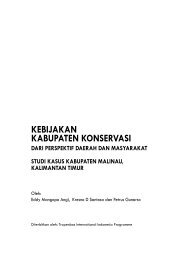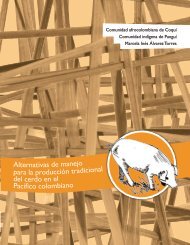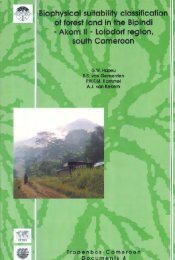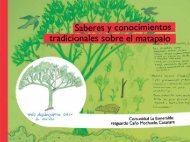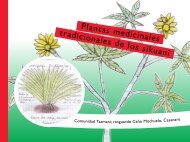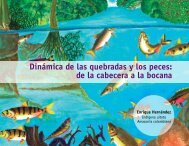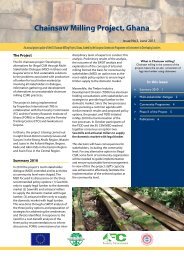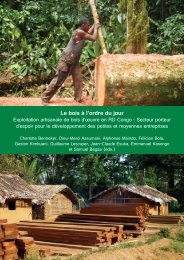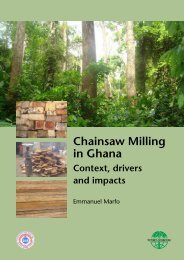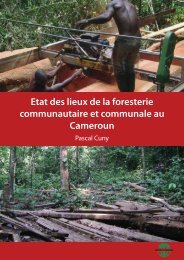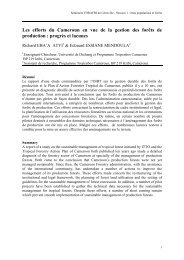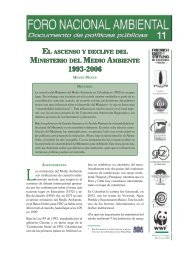Download the publication - Tropenbos International
Download the publication - Tropenbos International
Download the publication - Tropenbos International
Create successful ePaper yourself
Turn your PDF publications into a flip-book with our unique Google optimized e-Paper software.
Central African tropical rain forest structure and composition<br />
2. Lowland evergreen forest rich in Caesalpinioideae, with Calpocalyx heitzii and<br />
Sacoglottis gabonensis (Caesalpcasa).<br />
This forest type is unique in Cameroon and only occurs in <strong>the</strong> Campo area between<br />
50-200 m above sea level (Letouzey, 1985; Kaji, 1990; Thomas & Thomas, 1993;<br />
Sunderland et al., 1997). Although it is similar in structure and composition to <strong>the</strong><br />
lowland evergreen forest rich in Caesalpinioideae, it is characterised by its<br />
abundance in Caesalpinioideae, Calpocalyx heitzii and Sacoglottis gabonensis.<br />
These species often occur in association with Alstonia boonei, Calpocalyx dinklagei,<br />
Desbordesia glaucescens, Greenwayodendron suaveolens, Irvingia gabonensis,<br />
Meiocarpidium lepidotum, Piptadeniastrum africanum, Ochthocosmus calothyrsus,<br />
and Terminalia superba.<br />
Table 2.1 Vegetation types derived from multivariate analyses with map code, altitudinal range, annual<br />
rainfall and degree of disturbance.<br />
Map code Vegetation types Altitudinal Rainfall Degree of<br />
range (m) (mm/year) disturbance*<br />
Caesalp Lowland evergreen forest rich in<br />
Caesalpinioideae<br />
100-700 1750-2000 a, b, c & d<br />
Caesalpcasa Lowland evergreen forest rich in<br />
Caesalpinioideae with Calpocalyx heitzii and<br />
Sacoglottis gabonensis<br />
50-200 2200-2800 b, c & d<br />
Caesalpsa Lowland evergreen forest rich in<br />
Caesalpinioideae with Sacoglottis gabonensis<br />
and o<strong>the</strong>r coastal indicators<br />
50-350 2600-2950 b, c & d<br />
Cosaga Coastal forest rich in Sacoglottis gabonensis 0-100 2800-2950 b, c & d<br />
Cosaca Coastal forest rich in Sacoglottis gabonensis<br />
and Calpocalyx heitzii<br />
0-100 2700-2800 b, c & d<br />
Mixevergreen Mixed evergreen and semi-deciduous forest,<br />
with elements of evergreen forest predominant<br />
100-700 1750-2000 a, b, c & d<br />
Mixsemideci Mixed evergreen and semi-deciduous forest,<br />
with semi-deciduous elements predominant<br />
100-700 1670-1750 b, c & d<br />
Submontane Submontane forest on hilltops 800-1100 1800-2000 a<br />
Swamp Seasonally flooded and swamp forests 0-500 1670-2950 a & b<br />
Mangrove Mangrove rich in Rhizophora racemosa and<br />
Pandanus species<br />
0-30 2800-2950 a & b<br />
Cosas Coastal vegetation on sandy shorelines 0-20 2800-2950 d & e<br />
Hevecam Industrial rubber plantation 0-100 2600 e<br />
Socapalm Industrial oil palm plantation 0-100 2950 e<br />
* Where, a: virtually undisturbed except for hunting and <strong>the</strong> collection of non timber forest products; b:<br />
small patches (50%) of forest degradation; and e: no natural vegetation left. Cosas forms a narrow strip along <strong>the</strong><br />
coast that cannot be depicted on <strong>the</strong> vegetation map because of its scale.<br />
25



